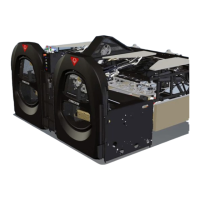Troubleshooting
400-088-120-02 Page 4.6-1 Rev. Date: 10/2016
4.6 Troubleshooting
4.6.1 Troubleshooting Tools
4.6.1.1 Continuity Tester
Using the continuity tester on live circuits can damage the tester.
1. Open Circuits
A. To check the continuity of any wire, disconnect one end of the wire.
B. Connect one side of the tester to one end of the suspect wire, and the other side of the tester to the
end of the disconnected wire.
C. If the wire is good, the tester should read zero and/or beep. If the wire is open, the tester will not
react.
2. Shorts
A. To check for a short between two wires, disconnect both ends of the suspect wires.
B. Connect the tester to one end of each wire. If tester lights, the wires are shorted. If tester does not
light, the wires are not shorted.
3. Grounds
A. To check for a ground, disconnect both ends of the suspect wire.
B. Connect one side of the tester to the machine’s frame (bare metal) or to a conduit and the other
side of the tester to one end of the wire being tested.
C. If the wire is grounded, the tester should light. If the wire is not grounded, the tester will not light.
4.6.1.2 Voltage Tester
For use on alternating or direct current (AC or DC) between 80 and 600 volts. All
power to the component to be tested should be turned on. Caution should be
used when testing live circuits.
A. To check for voltage, connect the tester across the hot leads (line) on the device to be tested. The
neon bulb will glow if voltage is present. When checking across 220 volts, the neon bulb will be
twice as bright as when checking 110 volts. The tester cannot be used.

